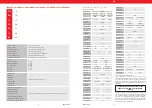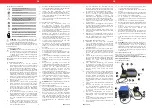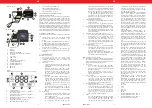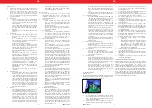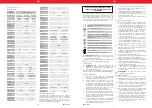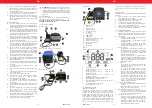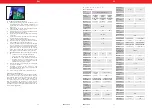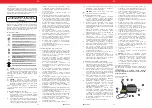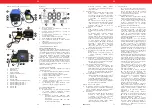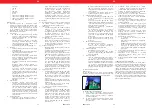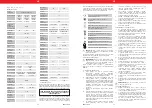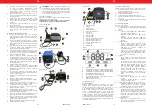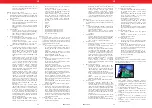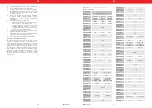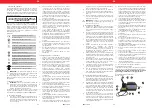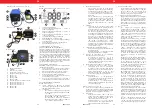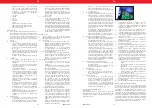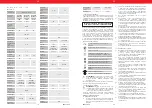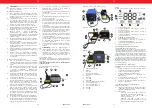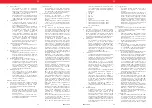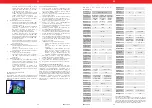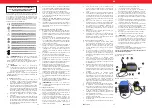
16
17
08.07.2020
08.07.2020
I N S T R U K C J A O B S Ł U G I
PL
EN
DANE TECHNICZNE
Opis
parametru
Wartość parametru
Nazwa
produktu
CYFROWA
STACJA
LUTOWNICZA
80W
CYFROWA
STACJA
LUTOWNICZA
100W
CYFROWA
STACJA
LUTOWNICZA
80W
Model
S-LS-62
S-LS-63
S-LS-64
Napięcie
zasilania [V~]/
Częstotliwość
[Hz]
230/50
Moc [W]
80
100
80
Zakres
temperatury
[°C]
150-450
Stabilność
temperatury
+/- 2%
Dokładność
wskazań
temperatury
[°C]
+/- 10
Rezystancja
grota [Ω]
< 2
Prąd
znamionowy
[A]
0,4
0,5
0,4
Bezpiecznik
3A
1 A
Potencjał
uziemienia na
grocie [mV]
< 5
< 2
Klasa
ochronności
I
Klasa ochrony
IP
IP20
Wymiary [mm]
115x145
x96
115x173x 100
Ciężar [kg]
1,73
2,48
Nazwa
produktu
CYFROWA STACJA
LUTOWNICZA 60W
CYFROWA STACJA
LUTOWNICZA 75W
Model
S-LS-65
S-LS-68
Napięcie
zasilania [V~]/
Częstotliwość
[Hz]
230/50
Moc [W]
60
75
Zakres
temperatury
[°C]
150-450
200-480
Stabilność
temperatury
+/- 2%
Dokładność
wskazań
temperatury
[°C]
+/- 15
+/- 10
Rezystancja
grota [Ω]
< 2
Prąd
znamionowy
[A]
0,3
0,54
Bezpiecznik
1 A
Potencjał
uziemienia na
grocie [mV]
< 2
Klasa
ochronności
I
Klasa ochrony
IP
IP20
Wymiary [mm]
115x173x100
115x145x96
Ciężar [kg]
1,83
1,81
Nazwa
produktu
CYFROWA STACJA
LUTOWNICZA 150W
CYFROWA STACJA
LUTOWNICZA 90W
Model
S-LS-71
S-LS-72
Napięcie
zasilania [V~]/
Częstotliwość
[Hz]
230/50
Moc [W]
150
90
Zakres
temperatury
[°C]
150-450
100-500
Stabilność
temperatury
+/- 2%
Dokładność
wskazań
temperatury
[°C]
+/- 10
Rezystancja
grota [Ω]
< 2
Prąd
znamionowy
[A]
0,7
0,5
Bezpiecznik
2 A
1 A
Potencjał
uziemienia na
grocie [mV]
< 2
Klasa
ochronności
I
Klasa ochrony
IP
IP20
Wymiary [mm]
125x155x112
115x173x100
Ciężar [kg]
1,72
2,38
3.5. CLEANING AND MAINTENANCE
a)
Unplug the mains plug and allow the device to cool
completely before each cleaning, adjustment or
replacement of accessories, or if the device is not
being used.
b)
After cleaning the device, all parts should be dried
completely before using it again.
c)
Store the unit in a dry, cool place, free from moisture
and direct exposure to sunlight.
d)
Do not spray the device with a water jet or submerge
it in water.
e)
Do not allow water to get inside the device through
vents in the housing of the device.
f)
Clean the vents with a brush and compressed air.
g)
The device must be regularly inspected to check its
technical efficiency and spot any damage.
h)
Do not use sharp and/or metal objects for cleaning
(e.g. a wire brush or a metal spatula) because they
may damage the surface material of the appliance.
i)
The outer cover of the device can be cleaned
with a damp cloth, using a small amount of liquid
detergent. Do not use solvents to clean the cover.
j)
IMPORTANT: Please remove and clean the soldering
tip:
• at least once a day after non-intensive use,
• every time after moderate and intensive use.
• IMPORTANT: If a new soldering tip has been
installed, remove any accumulations in the
fixing part. Otherwise, the tip may melt into the
heating element or the fixing part.
k)
Remove the loose accumulation on the soldering tip
to prevent cold solder.
l) Prolonged operation of the device at high
temperatures (above 400°C) may shorten the life
span of the soldering tip.
m) Never clean the tip with a file or abrasive material.
DISPOSING OF USED DEVICES
Do not dispose of this device in municipal waste systems.
Hand it over to an electric and electrical device recycling
and collection point. Check the symbol on the product,
instruction manual and packaging. The plastics used
to construct the device can be recycled in accordance
with their markings. By choosing to recycle you are
making a significant contribution to the protection of our
environment. Contact local authorities for information on
your local recycling facility.


